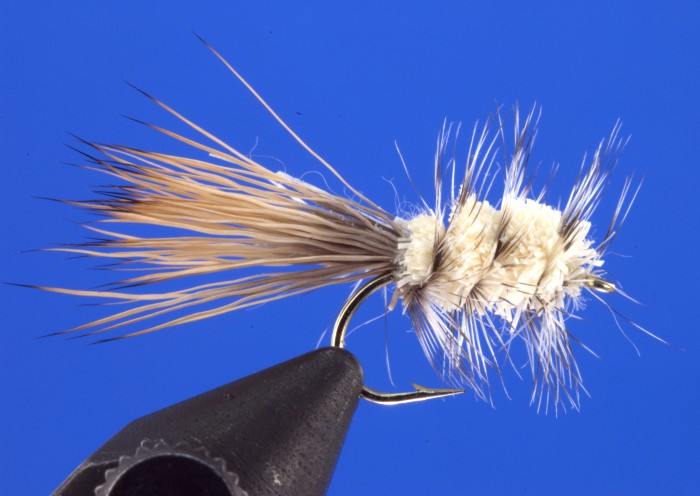Hoppers and Attractors
When my dad and my cousin Jon and I first learned how to fly fish Hoppers Goofus Bugs and Royal Wulffs were all we knew. Grass hopper fishing is at its best in Summer, which for most of us is another way of saying "on vaction." What's not to like? Grass Hoppers meant Joe's Hoppers then. Now they are are all made with foam. Almost every tier I know has his or her own signature foam hopper. The one the stores sell most is the Chubby, which used to be the Chubby Chernoble.
Chubbies catch fish in their own right, they never sink and they can also be bobbers for a trailing nymph. A Chubby Dropper rig is the most reliable way for guides to put inexperienced fisherman into good fish.
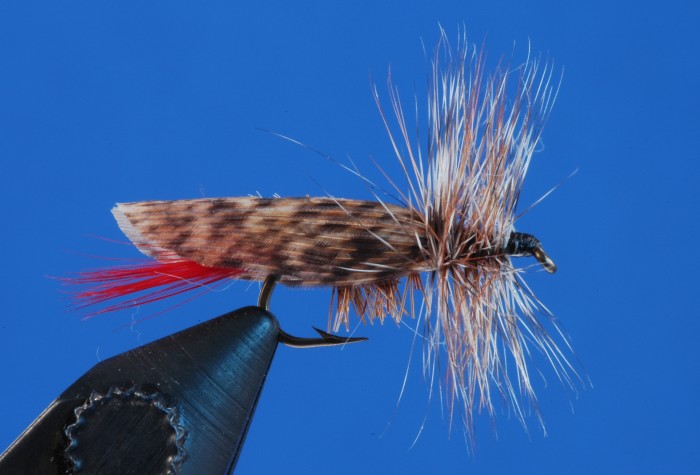
So what is an attractor dry fly? I doubt there is much argument. An attractor is any medium to large size, high visibility dry fly fished in the absence of an ongoing hatch. Dry fly attractors are how most of us learn about fly fishing. It is the easiest way to fish. When they work it's also the most fun.
Watching a fish rise up and suck down a large dry fly is hard to beat. Fishing small flies in smooth water during insect hatching events is usually associated with concentration, with high difficulty and with narrow, intensely peering eyes. Fishing Royal Wulffs in rolling big river water is not only fun, it's easier. Attractors are still my favorite way to fish. At least when it works.
But don't let easy fool you. Attractors are often the smartest choice. I guided a gal for three days once who was staying at Tom Brokaw's ranch on the West Boulder. She said her husband was chief counsel for NBC. But he was a hiker and not a fisherman. She grew up fishing with her dad and she wanted to fish. What a gal. She was smart and stunningly beautiful. She said she'd worked as a human rights lawyer in Nicaragua and had also "worked her way through Stanford Law School" doing TV commercials. She'd done this before. We hatched a conspiracy to get her photo on the front page of a fishing magazine. She was a real pro and knew what to do at every moment. She not only knew how to fish she knew how to throw her hat back so her face wouldn't be in the shade, and she could flash a continental smile on a moment's notice. During one morning in a high altitude Cutthroat meadow up in Yellowstone Park I notced a particularly nice run. "You'll catch a big one here," I announced. I had her fishing with a big two inch long gray and yellow foam hopper. Two casts and bang, we had an 18" fish in the net with the sun behind me and smile so big you could power a thousand TVS.
"So tell me," she asked. "You called that fish! How did you know?" I thought about it for a minute and said: "Just looking at it. There was depth current and a clean gravel bottom with no silt. That was the best holding water we've seen all day." What I did't say was "And this is a cutthroat creek. A nymph or a small dry fly might have caught a fish. But a big grass hopper will for sure. Every time."
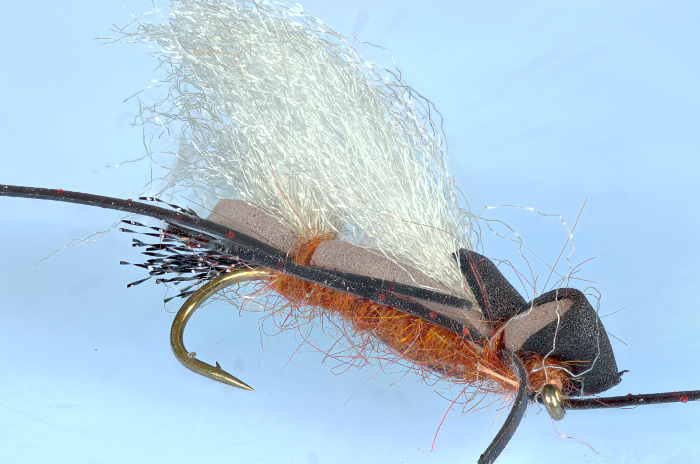
Big hi-vis attractors are not to be looked down on as a beginner's easy choice. They are often just what the doctor ordered. Sometimes better than anything else you might be tempted to try. A few days later some rural Rocky Mountain meth heads at the 9th Street Bridge in Livingston Montana broke the window out of my truck and stole my camera bag and camera. My home-owner's insurance bought me a new camera. But five rolls of incalculably valuable 35mm slide film were gone forever.
Royal Wulff
The grand champion attractor has to be the Royal Wulff. How would an internet algorithm try to rate flies? They might use a series of multiplication constants that get tuned and fine-tuned until they start to produce the answers they want. For each fly they could use a multiplication factor for average number of strikes per hour times how close it comes to being a fly shop's best seller times another factor for how long it's been around. That way flies that have been top performers for a century now would still rank higher than this year's latest foam Hoobie Doobie. Lee Wulff made the first Royal Wulff in the late 1920s or early 1930s and it's still everybody's favorite fly. It floats like a cork you can see it from a mile away. And fish bite it. All summer long. That's hard to argue with.
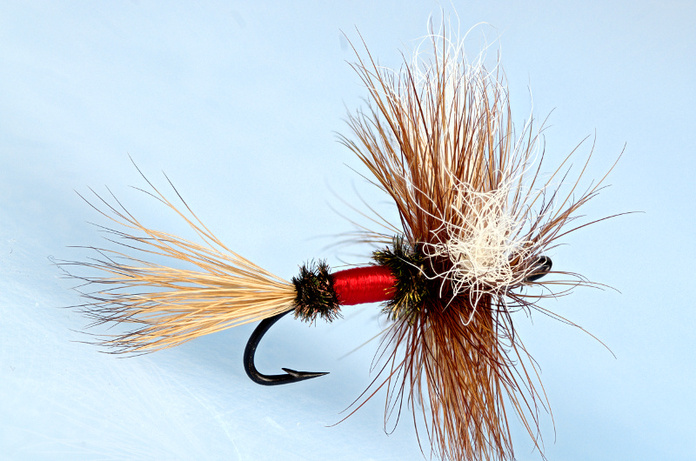
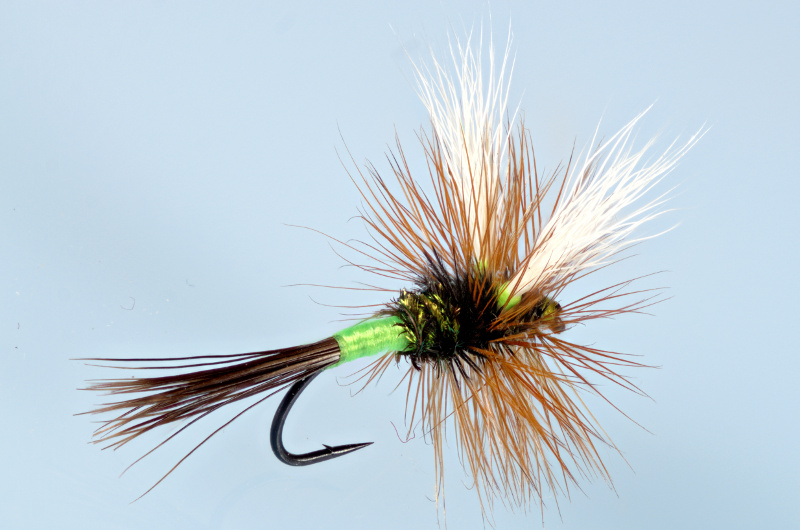
Sandy's Bobber Hopper
There really isn't anything special about my hopper, compared to any other. Other than it's my hopper so I like it best. One thing I do that only a few others do is to add foam kicker legs. I started doing that decades ago as a desperate way to force my hoppers not to land upside down. It works. Most of the time anyway. But it turns out to be more of a human requirement than a piscatorial one.
One August day quite a few years ago my wife Adele and I did a long float from Sheep Mountain all the way down to Springdale on the Yellowstone. On a bright sunny summer day. But no sooner did I start rowing when the wind came up. The Yellowstone is famous for its hellatious winds but this was extreme. This was not a thunderstorm rolling in. It stayed sunny and bright the whole way but the wind was so strong it was dangerous. It was all I could do to keep my drift boat from flipping. This was a downstream wind too, which is far more dangerous than a wind blowing backback upstream. I had to keep pointing straight downstream without ever getting sideways to that gale force wind, which got dicey at log jambs, channel splits and mid-river boulders. I did my best to act like it was no big deal but it was damned scary. In the middle of all this the wind was blowing hoppers onto the water like rain after a hurricane. The fish went absolutely nuts. Fishing was out of the question. It was all I could do to keep us alive and Springdale was still a good ten miles downstream yet to go.
The punchline to the story is what happens to grass hoppers when they hit the water. They don't like it a all. They kick and wriggle furiously until they drown or give up and die. And when they do stop kicking they roll over and float belly-up. Not most of them. All of them. And the fish could care less. They eat every hopper they can: alive upright and kicking or dead belly-up and dead drifting. It doesn't matter to them. I still tie my hoppers with foam kicker legs and they do land upright. Most of the time. But now I know it doesn't matter.
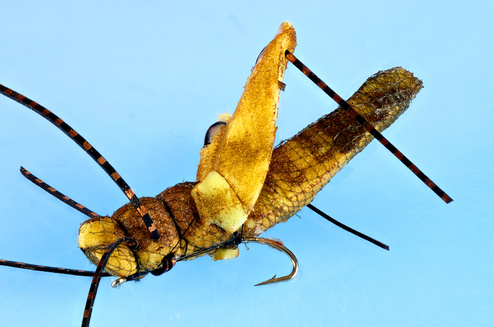
Morman Cricket
My favorite time and Rocky Mountain place to fish hoppers is high mountain meadows in mid-summer. Cutthroats are particularly fond of hoppers. High altitude habitats are hard places to make a living. Hoppers are an impotant late summer food source for high altitude fish. Fishermen are not scientists. Not most of us anyway. I don't have anything resembling data but I do have a lifetime's experience telling me high altitude cutthroat trout have evolved to have beahaviors that include looking watching and waiting for grass hoppers to appear. And Mormon Crickets too.
Mormon Cricket flies are just brown grass hoppers made a bit shorter but taller and fatter. Cutthroats have a substance abuse problem with Mormon Crickets.
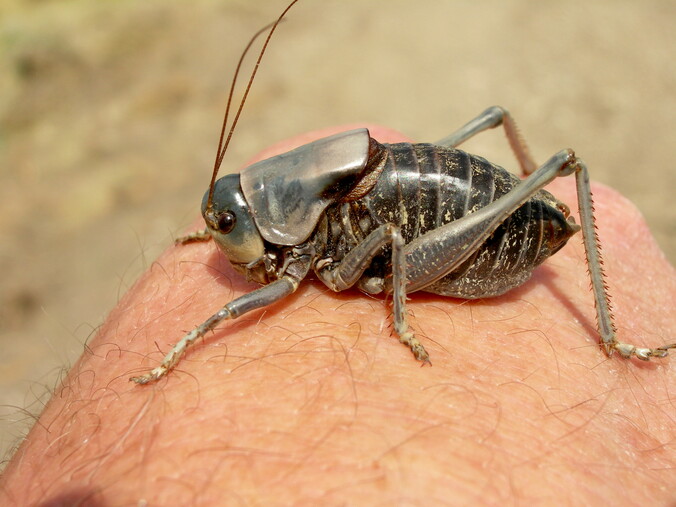
Pat Barnes
I spent the night with Pat and Sig Barnes at their house in Helena Montana a few years before Pat died. Pat and I fished the Missouri the next day, using one of my boats I'd pulled all the way up from Bozeman. Pat proudly showed me his grasshpper board, which I think was down in their basement then, where Pat did most of his tying? It was a long time ago. I might be getting the details wrong.
I was a little miffed Pat didn't ask me to contribute a hopper. I think I did already have a Fly Tyer Magazine article published at that point, that was aobut my early versions of foam Salmon Flies and Hoppers. It's possible Pat had not seen it. I don't keep up that well myself anymore.
My dad's favorite fly was the Joe's hopper. Pat liked that fly too. Are there any foam hoppers on Pat's famous board, now at the AFF Museuum? I'm not sure. I'll try to find out. Foam was just starting to happn then. Foam hoppers are most of the story now.
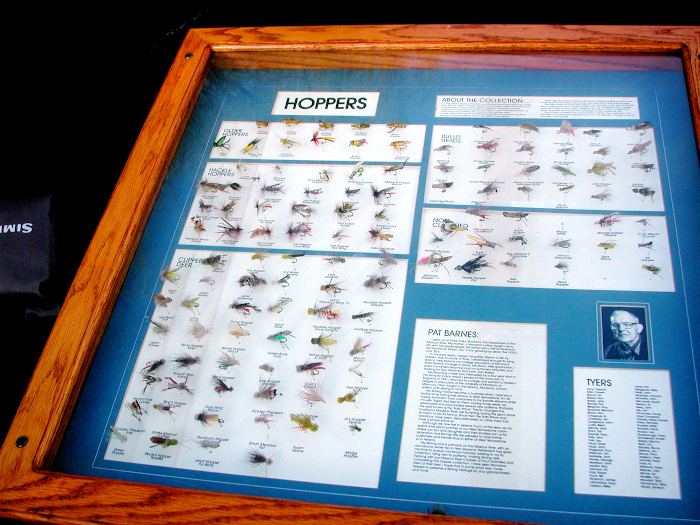
Sofa Pillow -- the Stimulator's great uncle
The Sofa Pillow started off as big Salmon Fly imitation for the Madison River, designed and first tied by Pat Barnes. Today's highly popular Stimulator slicker, more refined adaption of the same fly. My dad caught his biggest trout of a lifetime on a Sofa Pillow, long after the Salmon Fly hatch was over--a nifty 25" inch male brown with a jaw. There is an old 35mm slide somewhere, of him trying to get that fish to stay in his net. Colin--my dad--gave that fish a name. He was nenceforth known as Wally. Colin fished Sofa Pillows for years after that. Today most people use Stimulators. They are good flies, a bit better looking too. But they're still basically the same fly.
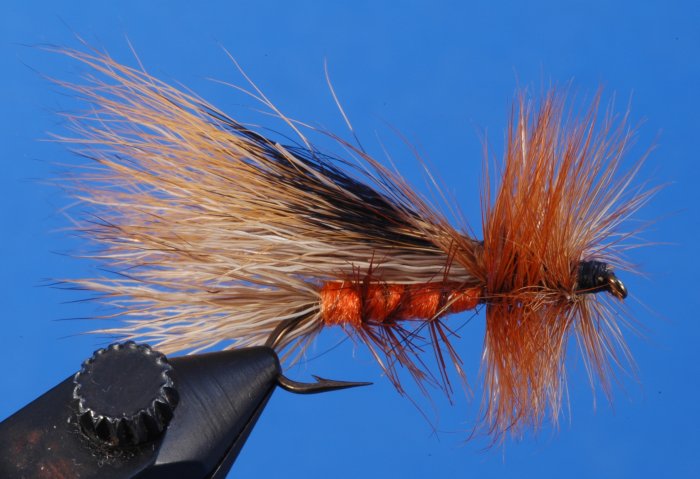
Werewolf
Most of my early creative work is long gone. The Werewolf is the only fly I made 40 years ago I still use, although maybe not the way it was originally intended. This was supposed to be hi-visibility champion floater with a vaguely grass hopper like silhouette, made in the days before closed cell foam arrived. That's how I used it then too. Now it has a different role.
The Werewolf is still a great floater but for hopper fishing I--like everybody else--make foam hoppers now. The Werewolf turns out to be a special purpose fly I don't use often, but I am oh so glad I have it when I do. The Werewolf makes a really good soft landing, no plop bobber for a trailing nymph of some kind. Moreover it's a bobber that also catches fish. Like all bobber-hopper-dropper rigs the trailing nymph or wet fly catches most of the fish. But the few fish the bobber does catch often end up the biggest fish of the day.
I got lucky once and ended up as a fly fishing model for an ESPN fly fishing photo shoot. Photographer Ross Dettman was hired by ESPN to illustrate a nifty piece of writing about Tom Morgan, written by Wright Thompson. Ross purchased all four slots on a nearby Southwest Montana Spring Creek for three days straight. I wasn't expected to say anything, this was a still photography project. They did want somebody to hold and cast a rod who looked natural doing it. I just had to comb my hair and wear a clean shirt. And cast. I learned so much about professional photography, working with Ross, it's hard to put in words. For three days in a row, starting at 9:00am or so we set up tripods, experimented with camera positions and took photos. If you have a good idea what you want and shoot two or three exposures you might get what you wanted. If you shoot for two hours you know you'll get what you want. From about noon on I had the whole place to myself, at prime Pale Morning Dun time too, for three straight days. When I look back on it now that had to be three of most fun fishing days I've had.
On spring creeks I like to keep my feet out of the water as much as possible. Too many humans on a daily basis really tears the place up. I also found, at least on this creek, the minute I put my feet in the water the fish all scattered to their hiding places. So I spent a lot of time stalking up and down grassy banks, leaning out over the water and casting as far upstream as I could. I put on a medium-sized maybe #12 Werewolf followed by 24" to 36" inches of tippet and a Pale Morning Dun nymph and wacked'em silly for three days straight. The Werewolf was imporant. I was casting so far upstream I couldn't keep track of a small half sunken fly, without the big white-headed hopper a few feet away. A foam hopper splashes when it hits the water and these were spooky fish. The Werewolf landed silently every time, like an owl hunting mice at night. In three days of fishing I knocked'em pretty hard with those PMD emergers and only took three or four fish with the Werewolf the whole time. But also fitting a long established pattern, the three or four fish that did eat the Werewolf where all in the 18" to 22" in range. In retrospect you could use a Stimulator much the same way, as a silent-landing no plop bobber. The white antelope head on the Werewolf, however, does show up from a half a mile away.
The Werewolf is an important long term part of my asenal now.
